#piperaceae
Text
#2407 - Piper excelsum - Kawakawa


AKA Macropiper excelsum. The name kawakawa comes from the Māori kawa meaning bitter, and while it certainly is, probably refers to the related Kava (Piper methysticum) which can't grow in New Zealand's cooler climate but is widely used in the Pacific Islands to produce a ritual drink with medicinal, anesthetic, euphoriant, and entheogenic properties. The Māori word kawa also means "ceremonial protocol"
A small tree endemic to New Zealand; the subspecies P. e. subsp. psittacorum is found on Lord Howe Island, Norfolk Island and the Kermadec Islands.
Kawakawa was used as a medicinal plant by the Māori. An infusion made from leaves or roots or chewed leaves were used to relieve toothache, and wounds were often bound in kawakawa leaves. The edible yellow berries were eaten as a diuretic. Traditionally, leaves with holes chewed by caterpillars of the kawakawa looper moth (Cleora scriptaria) were considered the best to use - not implausible, if the plant increases production of bioactive molecules in response to insect attack.
In cultural contexts, host people of a marae wave leaves of kawakawa to welcome guests. At a tangi, both hosts and guests may wear wreaths of kawakawa on the head as a sign of mourning.
Early European settlers to New Zealand used kawakawa in teas, and experimented using it as a flavouring agent in beer. Since the contains the deliriant myristicin, this was probably a memorably bad idea.
New Plymouth, Taranaki Ringplain, New Zealand
#kawa#kawakawa#piper#piperaceae#new zealand plant#medicinal plant#new plymouth#taranaki ringplain#macropiper#cleora#kava
3 notes
·
View notes
Text
पान II Piper_betle II Laxative, Oral_hygiene, Psychosomatic_disorders, मानसिक_समस्याओं congestion
Safer-Effective-Better-Remedy
#पान #paan #Piper_betle #Laxative #Oral_hygiene #piperaceae #antioxidants #flavonoids #polyphenolic_compounds #Psychosomatic_disorders #मानसिक_समस्याओं #congestion #Cataract #diy #nature #drlalit #traditional #fitness #healthcare #healthy #neuralgia #macrominerals #microminerals #myalgia #anticancer #Nutritious #Nature #Immunomodulator #DIY #antihyperalgesic #kidneystone #water…
youtube
View On WordPress
#Ayurveda#Ethnomedicines#Herbal#Homoeopathy#Laxative#Medicinal plants#One health concept#Paan#Piperaceae#Psychosomatic_disorders#Remedies#Unani#Youtube
0 notes
Text
Kava Root Powder

Kava, otherwise known as Piper methysticum, is part of the Piperaceae (pepper) family and is a bush like plant. The roots are considered an herbal supplement known to be used in drinks and teaa that are shared in relaxing social environments. Drinking Kava promotes peoples drive to be social and in turn more relaxed and friendly in the environment.
Kava Root Powder
1 note
·
View note
Text

Unlocking the Mysteries of Kava: A Comprehensive Guide to the Ancient Polynesian Elixir
Kava, the traditional ceremonial beverage of the South Pacific, has gained popularity beyond its native shores. With a rich cultural history and unique psychoactive properties, kava has become a subject of interest for those seeking relaxation and an alternative to other beverages. In this comprehensive guide, we’ll explore kava-kava’s origins, cultural significance, preparation methods, health benefits, and potential risks associated with kava consumption.
Origins and Cultural Significance
Kava, scientifically known as Piper methysticum, is a crop native to the islands of the South Pacific, including Fiji, Vanuatu, Tonga, and Samoa. The plant’s name, Piper methysticum, translates to “intoxicating pepper,” reflecting its traditional use as a ceremonial and social beverage.
In traditional Polynesian cultures, kava holds deep spiritual significance. It is often consumed during ceremonies, rituals, and social gatherings to foster a sense of community and connection. The plant is considered a gift from the gods, and the preparation and consumption of kava are surrounded by sacred rituals.
Botanical Profile of Kava-kava
Kava is a member of the pepper family (Piperaceae) and is distinguished by its large, heart-shaped leaves and long, slender stems. The part of the plant used for consumption is the root, which contains a unique combination of compounds known as kavalactones. These kavalactones are responsible for the psychoactive effects of kava.
Preparation and Consumption
Preparing kava-kava involves grinding the root into a powder, which is then mixed with water to create a beverage. Traditional preparation methods may include straining the mixture through a porous cloth to remove fibrous material. The resulting liquid, often described as earthy and mildly bitter, is consumed in ceremonial coconut shells called “bilo.”
Kava bars and cafes, which have gained popularity in Western countries, often serve kava in various forms, such as instant powders, capsules, or infused drinks. However, traditionalists argue that the traditional preparation method preserves the cultural and spiritual significance of kava consumption.
Psychoactive Properties of Kava-kava
The psychoactive effects of kava are attributed to its kavalactone content. Kavalactones interact with neurotransmitters in the brain, producing a calming and relaxing effect. Kava-kava is often sought after for its potential to reduce anxiety, stress, and promote a sense of well-being without causing sedation.
It’s important to note that excessive consumption of kava can lead to a condition known as “kava dermopathy,” characterized by dry, scaly skin. This condition is reversible upon discontinuation of kava use.
Health Benefits and Risks
Health Benefits
Anxiety and Stress Reduction: Kava’s anxiolytic properties make it a popular choice for individuals seeking a natural remedy for anxiety and stress.
Muscle Relaxation
Kava’s muscle-relaxing effects have led to its use for easing tension and promoting relaxation.
Sleep Aid
Some users report improved sleep quality after consuming kava.
Health Risks
Hepatotoxicity: Is Kava-kava a Blood Thinner?
Is Kava Bad for the Liver?
Controversy surrounds the association between kava-kava consumption and liver toxicity. While some studies suggest a potential link, others question the methodology used. Individuals with pre-existing liver conditions or taking medications should consult their healthcare provider before using kava. Additionally, the blood-thinning properties of kava raise concerns for those on anticoagulant medications.
Interaction with Medications
Kava may interact with certain medications, particularly those metabolized by the liver. Individuals taking medications should consult their healthcare provider before using kava.
Is Kava a Drug?
The classification of kava-kava as a drug is a matter of perspective and legal interpretation. While it is not considered a traditional recreational drug, kava’s psychoactive properties place it in a unique category, prompting discussions about its status in different regions.
Is Kava Better than Alcohol?
Kava is often considered an alternative to alcohol due to its relaxing effects without the impairing qualities. While personal preferences vary, some individuals choose kava as a social beverage, appreciating its ability to induce relaxation without the intoxicating effects associated with alcohol.
How Does Kava Make You Feel?
Is Kava a Good High?
The effects of kava include a sense of relaxation, stress reduction, and mild euphoria. It does not produce the same kind of high as recreational drugs, making it a popular choice for those seeking a milder and more natural way to unwind.
Can Kava Replace Alcohol?
While kava offers a unique and relaxing experience, it may not be a direct substitute for alcohol for everyone. The choice between kava and alcohol depends on individual preferences, cultural contexts, and the desired effects.
Legality and Regulation
The legal status of kava varies worldwide. Some countries have imposed restrictions or outright bans due to concerns about potential health risks. However, many regions, including the United States and parts of Europe, permit the sale and consumption of kava, provided it meets specific quality and safety standards.
Where Kava is Banned?
Due to concerns about potential health risks, some countries have imposed restrictions or outright bans on kava. It is essential to be aware of local regulations when considering the consumption or purchase of kava.
Conclusion
Kava, with its roots deeply embedded in Polynesian culture, has found its way into the global consciousness as a unique and intriguing beverage. Its psychoactive properties, cultural significance, and potential health benefits make it a subject of ongoing research and debate.
As interest in traditional and alternative remedies continues to grow, kava’s journey from the South Pacific to the world stage is likely to be one of curiosity, exploration, and cultural appreciation
Related: What Is Kanna? Natures SSRI. What Products To Buy In 2022?
#kava#greatcbdshop#greatproductsdistribution#counterculture#kavalactones#natural herbs#medicinal herbs#herbs#plantbased#plantbasedwellness#wellness#health and wellness#wellnessjourney#potent#polynesian
0 notes
Text
Różowy pieprz to owoc drzewa z gatunku Schinus molle (pieprzowiec peruwiański) lub Schinus terebinthifolia (pieprzowiec brazylijski), a nie prawdziwy pieprz, który pochodzi z rodziny pieprzowatych (Piperaceae). Choć nazywany "pieprzem", różowy pieprz nie jest bezpośrednio spokrewniony z czarnym, białym czy zielonym pieprzem, lecz pochodzi z rodziny nanerczowatych (Anacardiaceae). Ma łagodniejszy, owocowy smak, lekko pikantny z nutami cytrusowymi i żywicznymi dzięki czemu jest ceniony zarówno w kuchni jak i w aromaterapii.

Gdzie rośnie?
Różowy pieprz pochodzi z Ameryki Południowej, a jego naturalny zasięg obejmuje głównie:
Peru – Pieprzowiec peruwiański (Schinus molle) jest tam szeroko rozpowszechniony i ceniony od czasów prekolumbijskich.
Brazylia – Pieprzowiec brazylijski (Schinus terebinthifolia) jest rodzimy dla regionów południowo-wschodniej Brazylii.
Obecnie drzewa te rosną również w innych rejonach o ciepłym, tropikalnym klimacie takich jak:
Kalifornia i Floryda w Stanach Zjednoczonych,
Australia i Afryka (np. w Afryce Południowej),
Kraje basenu Morza Śródziemnego.
Drzewa różowego pieprzu są wytrzymałe i rosną na obszarach suchych często występując na terenach gdzie inne rośliny mają trudności z przetrwaniem. Owoce różowego pieprzu są małe o intensywnie różowym kolorze, a ich smak jest unikalnym połączeniem słodyczy i ostrości.
Wykorzystanie:
Kulinaria: Różowy pieprz jest używany jako przyprawa w kuchniach na całym świecie zarówno do dań mięsnych, rybnych, jak i deserów.
Aromaterapia: Olejek eteryczny z różowego pieprzu jest ceniony za swoje właściwości antybakteryjne, antyseptyczne i pobudzające.
Tradycyjna medycyna: W Ameryce Południowej różowy pieprz był używany w celach leczniczych do wspomagania trawienia i leczenia infekcji.
Różowy pieprz w aromaterapii
Różowy pieprz znajduje zastosowanie w aromaterapii gdzie wykorzystuje się jego olejek eteryczny pozyskiwany z owoców drzewa pieprzowca. Olejek doTerra charakteryzuje się ciepłym, pikantnym, lekko słodkawym aromatem z nutami cytrusowymi. W aromaterapii różowy pieprz jest ceniony za swoje działanie pobudzające, wspomagające koncentrację i poprawiające nastrój. Ma również właściwości wspierające układ odpornościowy i oddechowy.
Właściwości olejku z różowego pieprzu w aromaterapii:
Pobudzanie umysłu i koncentracji: Olejek z różowego pieprzu jest znany z właściwości stymulujących umysł i poprawiających zdolność koncentracji. Może być pomocny podczas nauki lub pracy wymagającej skupienia. Inhalacja jego aromatu pomaga w poprawie jasności umysłu i pobudzeniu do działania.
Redukcja stresu i napięcia: Chociaż olejek z różowego pieprzu pobudza ma także właściwości równoważące, które mogą pomóc w łagodzeniu stresu, lęku i napięcia emocjonalnego. Wdychanie jego zapachu wspiera relaksację i przywraca spokój.
Wspomaganie układu oddechowego: Olejek z różowego pieprzu może być stosowany w mieszankach aromaterapeutycznych w celu łagodzenia objawów przeziębienia, kaszlu oraz problemów z oddychaniem. Jego właściwości antybakteryjne i rozgrzewające pomagają oczyścić drogi oddechowe.
Wspomaganie trawienia: Wdychanie olejku z różowego pieprzu może również korzystnie wpływać na trawienie. Może pomóc złagodzić dolegliwości takie jak wzdęcia, niestrawność czy skurcze brzucha.
Wspieranie układu odpornościowego: Dzięki właściwościom przeciwbakteryjnym i przeciwgrzybiczym olejek z różowego pieprzu może być używany w mieszankach, które wspierają układ odpornościowy i chronią przed infekcjami.
Pobudzanie krążenia: Olejek z różowego pieprzu stosowany w masażach, pomaga poprawić krążenie krwi co jest korzystne dla osób z zimnymi dłońmi i stopami, a także może przyczyniać się do zmniejszenia napięcia mięśniowego.
Jak stosować olejek z różowego pieprzu doTerra Pink Pepper w aromaterapii?
Dyfuzor: Dodaj kilka kropel olejku do dyfuzora, aby odświeżyć i pobudzić umysł. Jego pikantny zapach doskonale nadaje się do stosowania w biurze lub podczas nauki.
Inhalacje: Wdychaj bezpośrednio z butelki lub aplikuj na chusteczkę, aby zredukować stres i poprawić nastrój.
Masaż: Rozcieńcz olejek z różowego pieprzu w oleju bazowym i wykonaj masaż, aby poprawić krążenie i rozluźnić mięśnie.
Kąpiel aromaterapeutyczna: Dodaj 3-5 kropli do ciepłej kąpieli, aby rozgrzać ciało, zrelaksować się i zredukować napięcie.
Olejek eteryczny z różowego pieprzu to wszechstronny produkt w aromaterapii, który łączy w sobie właściwości pobudzające i relaksacyjne. Pomaga w poprawie koncentracji, łagodzeniu stresu, wspomaganiu układu oddechowego i trawiennego, a także poprawia krążenie krwi. Dzięki swojemu charakterystycznemu, pikantnemu aromatowi, jest chętnie stosowany w mieszankach olejków eterycznych zarówno w celach terapeutycznych jak i kosmetycznych.

#RóżowyPieprz#Aromaterapia#OlejekEteryczny#Relaksacja#Antystres#Uspokajający#PodnosiNasrój#Oczyszczanie#Energia#Stymulacja#PoprawaNastroju#Odporność#PielęgnacjaSkóry#NaturalnaPielęgnacja#WzmacniaKreatywność#Detoksykacja#OlejkiEteryczne#ZdrowyStylŻycia#HolistycznePodejście
0 notes
Text
Healthy Living
Have you ever heard of the Maite plant? This unique plant is native to the tropical regions of South America and is known for its various medicinal properties. Let’s dive into what makes the Maite plant so special.
What is the Maite Plant?
The Maite plant, scientifically known as Piper aduncum, is a species of plant in the Piperaceae family. It is a perennial shrub that can grow up to 10 meters…
0 notes
Text
Karabiberin Faydaları ve Kullanım Alanları
Karabiberin Faydaları ve Kullanım Alanları
Karabiber Nedir?
Karabiber, Piperaceae familyasına ait bir bitkidir ve dünya çapında baharat olarak kullanılır. Siyah, beyaz ve yeşil biber gibi birçok çeşidi vardır. Karabiber, keskin ve baharatlı bir tada sahiptir ve yemeklere lezzet katmak için sıklıkla kullanılır.
Karabiberin Faydaları
Karabiber, sağlık açısından birçok faydası bulunan güçlü bir…
View On WordPress
0 notes
Text
Trip to Taiwan, April 2024 - Day 1: Gin&Tonic Pa
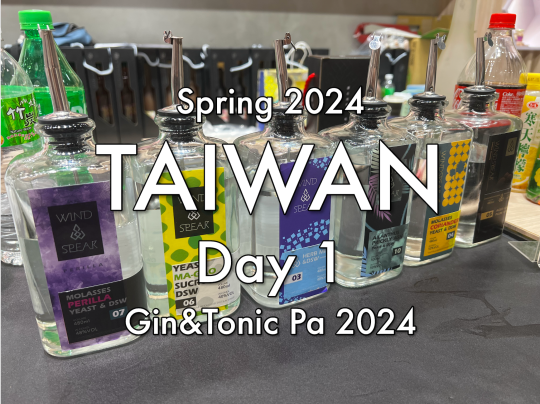
One of the purposes of this trip was the event called "Gin&Tonic Pa". "Pa” seems to stand for ‘Party,’ so it's a gin and tonic party.
今回の旅の目的の一つ、「Gin&Tonic Pa 大島琴酒節」。「Pa」は「Party」の略らしかったので、ジントニックパーティーってことね。
実は、「台北でジンのイベントがある」というXのPostを見て即チケットを買ったんだけど、どういうイベントかはわかっていなくてw 広い会場があるわけでもなさそうだし、どういうイベントなんやろかと謎のまま行ったのは秘密w

▲受付は迪化街のお寺「霞海城隍廟」の隣にあるでかい建物のところです。

▲「オーガナイザーのサム」がインタビューに答えていた
まずは、オンラインで購入した前売券のQRを受付で見せて、イベントのリストバンドとプラスチックグラスをゲット。迪化街に点在する会場になっているお店の中にあるブースでこれを見せると試飲ができる、という仕組みのイベントみたい。いわば「ボトル即売会の試飲し放題プラン」みたいなイベントなのね!(とここでやっと理解)

ちなみに、私が購入した前売券 NT$150は、おみやげボトルがついてくるプランだったので、どんなのがもらえるのかなと思っていたら、
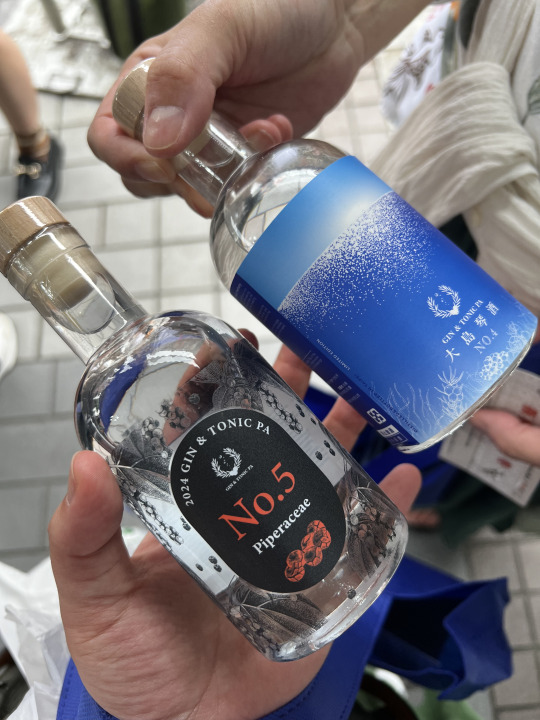
250mlサイズの、思っていたよりもしっかりしたボトルがもらえましたw これがもらえて、さらに試飲し放題で750円なんてお得なイベントじゃん〜!(後から調べたら、このボトルは販売価格NT$1000相当だったらしい。5000円...!?!?大盤振る舞いにもほどがあるぜ)
台湾のジンだけではなく、各国から輸入されたジン・リキュールも出店しているので、とにかく飲めるだけ飲みます。
まずは受付の隣にあったエリアの「PEDDLERS GIN Co.」ブース。
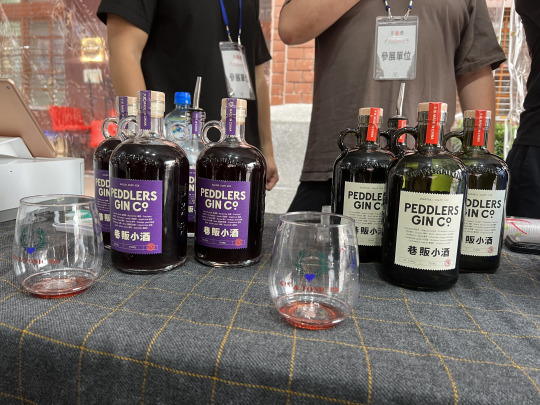
(欧州系のブランドかと思ってたら、ガッツリ中国のメーカーだった...!w 上海のメーカーなのかな。インスタもとてもオシャレである)
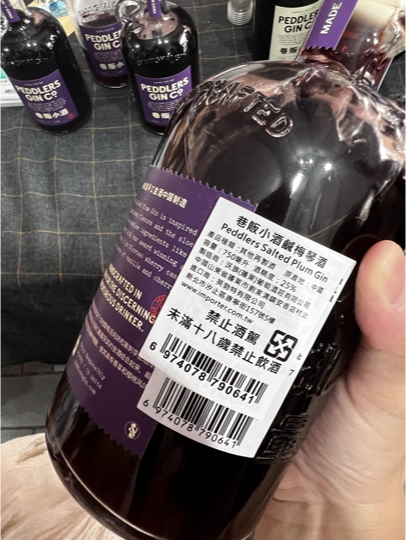
この「Salted Plum Gin」が、ジンっぽくなくて(というか、カテゴリ的にはリキュールだと思う)、梅というより梅干し感のある養命酒で面白かったです。
🐰「... これは ... あぶない ... ストレートで飲んでたら死ぬぞ...」
ということで、一旦コンビニでお水と炭酸を購入。会場で試飲するものに炭酸やトニックを入れてもらうにはお金がかかるようなのですが、セルフでやる分には問題なさそう。いざ次のお店へ。
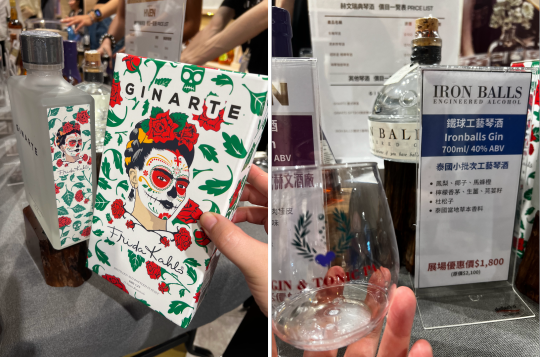
こちらは右手にまず輸入ブランドのブース。
「GINARTE」はめちゃくちゃパッケージ(箱のほう)が可愛い、イタリアのブランド。これはFrida Kahroというメキシコのアーティストのコラボイラストパッケージのものみたい。超可愛い。
そして大好き!なタイの「IRON BALLS GIN」。ボトルが個性的で、味もとてもエスニック。ボタニカルのポイントは陳皮だったような気がする。ひっさびさに飲んだけどやっぱり好きな味。またバンコクいきたいな...

そして左手は台湾ジンメーカー「東太陽製酒 East Sun Distillery」のブース。(ここのジン、パッケージに書かれている「WINDSPEAR」で調べても全く情報が出てこないのが謎w)
めちゃくちゃ種類があります。

「ボトル即売会」イベントなので、購入を目的に試飲してくださいね、ということなので、私も買いますよ。

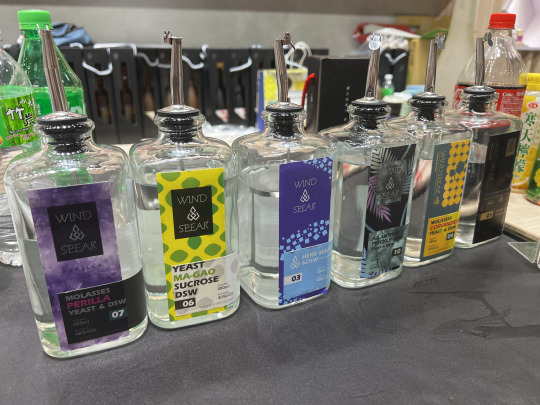
(みんながどんどん試飲くれっていうので、すでに並び順がバラバラである)
このナンバリング系は多分シングルボタニカルフォーカスなシリーズで、この中だったら
・No.4 香菜(パクチー)
・No.7 紫蘇(しそ)
が好みだったな。どっちもボタニカルをはっきり感じる良い出来。
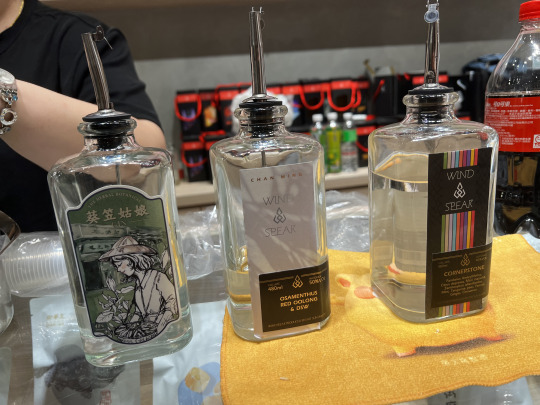
限定のも色々飲んで、いちばん可愛い「薔薇興虎」という限定のピンクのジンを買いました。ボタニカルは「玫瑰」(バラ)・「水蜜桃」(ピーチ)・「水梨」(なし)・「馬告」(マーガオ/山胡椒)。
たらふく飲んだので牡蠣オムレツ食べながら休憩して後半戦。

「Fleisch」というコーヒー屋さんのブースへ。
1Fはカクテルバー営業、2Fがボトル即売ブース、3Fが季の美のイベント会場。台湾では季の美がすっごく人気なのか、入口から大行列...我々は1Fと3Fはスルーで、2Fのブースに参ります。

▲「琴為何物」(ジンとは?)というネオンはこの日のために作ったものかな。カワイイ😍
2Fのボトル即売会ブースで、台湾ジンを狙っていただきます。

こちらは台湾・花蓮の蒸溜所「醲 NONG DISTILLERY」。

ここ、すごかった!!!このイベントに参加した中で一番の発見。
ここの「鰹」のジンがものすごく美味しくて、燻製した鰹チップの魚っぽいフレーバーと、なぜか感じる山椒っぽさで、コレめちゃくちゃ美味しかった!!!!わたしも友人も即決でボトル購入。いやー、いい出会いだった。
こちらは台湾ブランド「Valor」のブース。
(今みたら「Holy Distillery 合力」って書いてあったわ。台湾のクラフトジンの中では結構大きい蒸溜所だと思われる。)

ここもいろんなの出してたので、それぞれちょっとずつ。

最初にもらったボトルも、ここがOEMで作ってるっぽかったから、結構大手なんだろうなあ。
最後に「極」というジンブランドのブースへ。
ここだけ1SKUで1店舗確保されているから、結構大手なのかも...
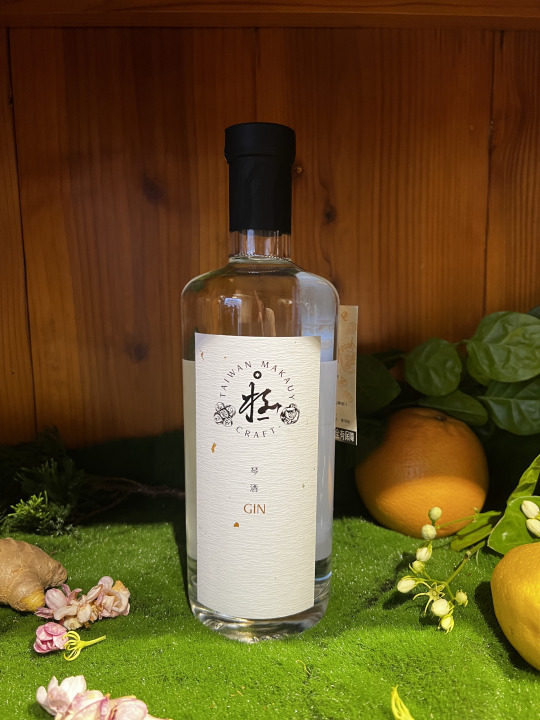
シンプルなデザインのラベルのジン。

(TTL 臺灣菸酒股份有限公司、って書いてあるので、国営のたばこ&酒会社ですね。そりゃ大手だわ)
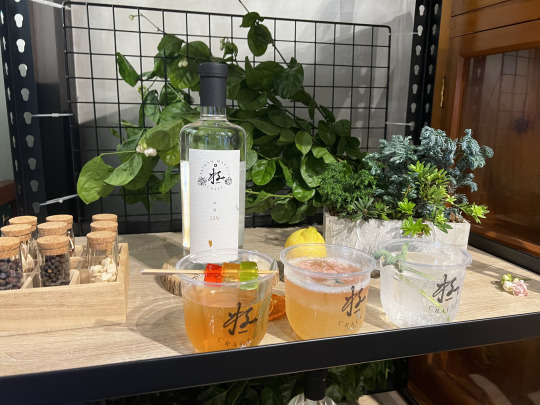
ここでは3種類のカクテルを提供。1杯NT$200なり。

「寶珠茉莉」というカクテルをいただきます。
「哈蜜瓜(ハミウリ)」というメロンとスイカの間みたいなジュースと、「茉莉緑茶(台湾ジャスミンティー)」、「桂花(キンモクセイ)」、「蘋果汁(りんごジュース)」のカクテル。
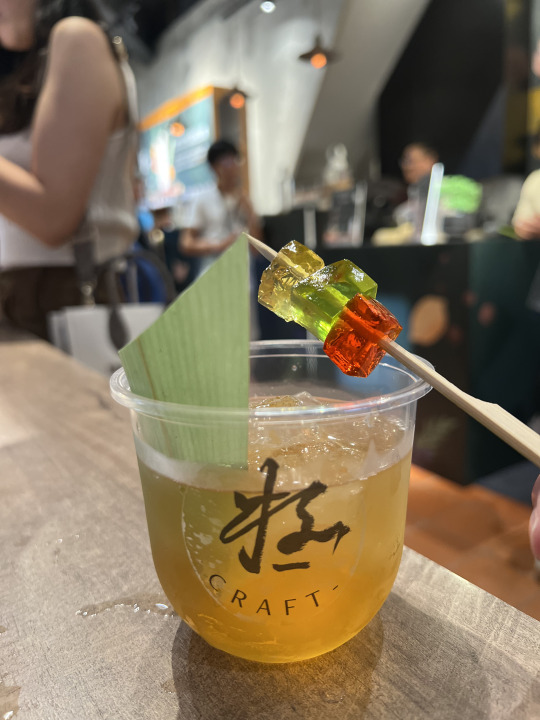
🐰「ほぼメロンジュース!!」

Mikkeller Taipeiでは、LONDON DRY GINの「BERRY BROS & RUDD」(イギリスの超老舗ワイン商みたい)のジンと、台湾の超有名カクテルバーのコラボがやってたみたいだけど、飲みすぎたのでここはスルー。これでほぼ全部のブースを回った感じでした。
かなりいろんなの飲んだ〜〜〜〜〜〜〜〜〜〜〜〜!!!!気温が高かったのもあって、全部回り切った時には汗だくw
最初はどんなもんやと思ってたけど、かなり楽しめたイベントでした。特に「鰹のジン」との出会いは衝撃だったね。行ってよかった〜!こういう酒イベントには旅行含めて積極的に参加していきたいと思いましたまる。
▼(追記1)Fleischで並んでいた時のひとコマ。

前に並んでいたおにいさんたちが、運営のおねえさんに話しかけながら、何やら自慢そうに大事に取り出したのは、「季能美」「軽井沢」「48%」と書かれた小瓶。

横にいたおにいさんが「えっ、マジで!?!?」と言わんばかりのリアクション。(これがめちゃくちゃ可愛かったw)そしてちょっとずつみんなで試飲。うわ〜〜〜これが台湾のジン界隈の民〜〜〜!!!日本にもおるわ〜〜〜〜どこの国でも界隈の人がやることはいっしょやわ〜〜〜〜!!!
ボトルに書いてあった内容から推察するに、季の美のバレルエイジのエディション「季能美」のレアものだったのでしょう。台湾のジン界隈のリアルな姿がめちゃくちゃ印象的でした。
※運営であろうおにいさんがめちゃくちゃ顔真っ赤で、「運営だけどこいつ飲んだな...」という顔してたのもなんか可愛かったw
▼(追記2)お土産のボトルたち
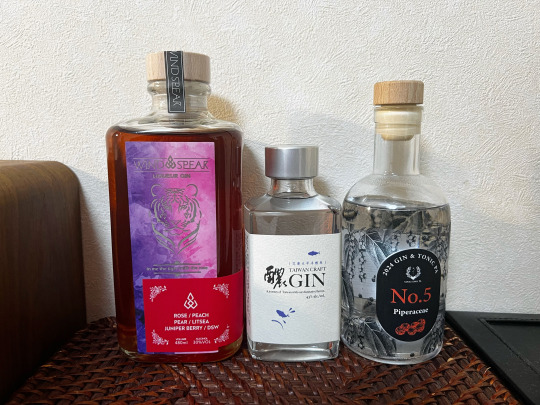
・薔薇興虎 / 東太陽製酒
・醲 GIN 花蓮太平洋鰹魚 / 醲 NONG DISTILLERY
・No.5 Piperaceae / 大島琴酒 - 台湾合力蒸溜所
「Piperaceae」は「コショウ科」という意味らしく、確かにかなり胡椒感のあるジン。原料は「甘蔗(さとうきび)」、「酵母菌」なので、サトウキビ原料の醸造酒をベースにしているみたい。ボタニカルに「杜松子(ジュニパーベリー)」「白胡椒」「緑胡椒」「黒胡椒」「五香粉(中国の代表的な混合スパイス)」「甘草」「大風藤(コショウ科の草で”オオカズラ”というものみたい)「海鹽(海塩)」。
飲んだ時に塩味を感じたので、なんだコレ、と思ったのですが、原料の最後に書いてある「海鹽」の「鹽」の字が細かすぎてOCRでも読み取れず...やっと今「海鹽」だということがわかりました。海水から生成した塩のことなのね。
▶︎Gin&Tonic Pa Instagram
【2024年4月 台北の旅】
・Day 0
・Day 1
└ 四海豆漿大王
└ 迪化街(油飯・蚵仔煎)&WANGTEA LAB
└ Gin&Tonic Pa 2024 👈THIS
・Day 2
・Day 3
0 notes
Text
Unveiling the Charm of the Pink Bubbles Plant: A Delightful Addition to Your Indoor Garden
In the world of indoor gardening, there's a captivating plant that's been stealing hearts with its unique appearance and cheerful demeanor—the Pink Bubbles Plant. With its whimsical pink-hued foliage and compact, bushy growth habit, this charming plant adds a touch of magic to any living space. Join us as we embark on a journey to explore the enchanting world of the Pink Bubbles Plant, uncovering its secrets and discovering why it's becoming a favorite among plant enthusiasts.
Meet the Pink Bubbles Plant: A Delight for the Senses
The Pink Bubbles Plant, scientifically known as Peperomia argyreia, is a member of the Piperaceae family and is native to South America. What sets this plant apart are its eye-catching leaves, which feature a striking pattern of silvery stripes and a blush of pink that resembles delicate bubbles dancing across its surface. The rounded leaves, reminiscent of small watermelon slices, create a captivating visual display that's sure to spark joy in any room.
Beyond its visual appeal, the Pink Bubbles Plant also delights the senses with its low-maintenance nature and compact growth habit. This plant is perfect for both novice and experienced gardeners, as it requires minimal care and thrives in indoor environments with bright, indirect light. With its petite size and bushy growth, the Pink Bubbles Plant is ideal for adorning shelves, desks, or any cozy corner in need of a pop of color.
Caring for Your Pink Bubbles Plant: Tips for Success
While the Pink Bubbles Plant is relatively easy to care for, providing the right growing conditions will ensure its health and vitality. Here are some tips to help your Pink Bubbles Plant thrive:
Light: Place your Pink Bubbles Plant in a location with bright, indirect light. Avoid direct sunlight, as it can scorch the delicate foliage.
Watering: Allow the soil to dry out slightly between waterings, then water thoroughly until the excess moisture drains from the bottom of the pot. Overwatering can lead to root rot, so it's essential to strike the right balance.
Humidity: Pink Bubbles Plants appreciate moderate to high humidity levels. You can increase humidity by placing a humidifier nearby or placing the plant on a pebble tray filled with water.
Temperature: Maintain temperatures between 65-75°F (18-24°C) for optimal growth. Avoid exposing the plant to cold drafts or sudden temperature fluctuations.
Fertilizing: Feed your Pink Bubbles Plant with a balanced, water-soluble fertilizer diluted to half strength every 4-6 weeks during the growing season (spring and summer).
By following these care tips and providing a little love and attention, your Pink Bubbles Plant will reward you with its charming presence and vibrant foliage, brightening up your indoor garden and bringing joy to your home.
Conclusion: Embrace the Magic of the Pink Bubbles Plant
In conclusion, the Pink Bubbles Plant is more than just a houseplant—it's a delightful companion that brings a touch of whimsy and charm to any indoor space. With its captivating pink-hued foliage and easy-care nature, this plant is a must-have for plant enthusiasts looking to add a pop of color to their home decor.
0 notes
Text
0 notes
Text
0 notes
Text
Exploring the Essence of Black Peppercorn: Culinary Staple and Flavorful Delight
Black peppercorn, scientifically known as Piper nigrum, is a quintessential spice that has left an indelible mark on the culinary world for centuries. The dried fruit of the flowering vine in the Piperaceae family, black peppercorns are renowned for their pungent flavor and aromatic qualities. This versatile spice has played a significant role in global cuisines, adding depth, warmth, and a distinctive kick to a myriad of dishes.
Originating from the Malabar Coast of India, black peppercorns have a rich history dating back to ancient times. They were once considered so valuable that they were used as a form of currency and were referred to as "black gold." The spice trade routes of old contributed to the spread of black peppercorns across the globe, becoming a staple in kitchens worldwide.
Black peppercorns come from unripe peppercorn berries that are harvested and dried. The drying process intensifies their flavor, resulting in the characteristic spicy and slightly pungent taste. These peppercorns are available in various forms, from whole to pre-ground, catering to diverse culinary preferences. However, the whole peppercorns, when freshly ground, offer the most robust flavor and aroma.
This spice owes its distinct taste to piperine, an active compound that contributes to its sharp and mildly spicy profile. Apart from enhancing the taste of dishes, black peppercorns are recognized for their potential health benefits. Piperine is believed to have antioxidant and anti-inflammatory properties, and it’s been associated with aiding digestion and nutrient absorption.
In the culinary world, black peppercorns are a ubiquitous seasoning used in a plethora of dishes. From enhancing the flavors of meats, soups, and stews to being a crucial component in spice blends like garam masala and curry powders, its usage is diverse. Its addition to salad dressings, marinades, and even desserts brings out a nuanced depth in taste that’s hard to replicate.
Chefs and home cooks value black peppercorns for their ability to elevate the simplest of dishes. Its presence in both savory and sweet recipes adds a dimension that balances and complements other flavors. The spice can also be a part of pickling solutions, adding a zesty tang to preserved foods.
In conclusion, black peppercorn is not merely a spice but a cornerstone of culinary excellence. Its rich history, distinctive flavor, and potential health benefits make it a beloved and irreplaceable component in kitchens globally. Whether it’s used in its whole form or freshly ground, this 'black gold' continues to reign supreme, enhancing dishes and delighting taste buds with its unmistakable allure.
0 notes
Text

Betel Leaf Oil (PB-001) Van Aroma
Van Aroma is one of the leading producers of Betel Leaf Oil. Van Aroma is one of the biggest exporters in Indonesia. We produce and export Betel Leaf Oil from sustainable, and fully traceable sources.
CAS Number : 84775-81-5
Chem/IUPAC Name: Piper Betle Leaf Oil
EINECS No: 283-910-2
Olfactory Profile: Phenolic, smoky, pungent, characteristic of betel leaf
Plant Part: Leaves
Betel Leaf Oil is the volatile oil obtained by the steam distillation of the leaves of the Pepper, Piper betle L., Piperaceae. Piper Betle Leaf Oil. Betel Leaf Oil by Van Aroma is an antimicrobial. It exhibits stimulating, carminative, aromatic, antiseptic, warming, and aphrodisiac properties. It is a good remedy for acne and black spots. It helps to treat skin ulceration, allergies, itchiness, and body odor. It also exfoliates dead skin that causes skin wrinkles and makes the skin look dull & rough. It blends well with lavender, tea tree, eucalyptus, rosemary and cardamom. Betel Leaf Oil is used in skin care applications and in Ayurveda for hair fall-related issues. It is REACH compliant.
For more info, visit our official website
0 notes
Text
Phylogenetics Reveals the Importance of Biodiversity to Food Plants in Mexico
Phylogenetics Reveals the Importance of Biodiversity to Food Plants in Mexico
https://ift.tt/ZiL5xVS
Díaz-Toribio and colleagues recently published a paper in AoB PLANTS about the evolutionary relationships and usage patterns of edible native plants in the Gulf of Mexico region. Their research gives insights into which plant groups have been preferred and selected for food over time, indicating the breadth of human diets and the use of regional flora resources.
They found that condiment species like peppers showed phylogenetic clustering, meaning related species were repeatedly used for the same purpose over time. Plant groups with wide leaves used for wrapping tamales also showed evolutionary convergence. Wild and cultivated edible plants belonged to identical lineages, with different species swapped in and out, showing people relied on the same useful plant families. However, wild versus cultivated plants used for condiments did come from different lineages.
Understanding patterns in the traditional use of native plants gives clues to their potential nutritional value and biocultural heritage. Archaeologists believe Mesoamerica was a key centre of plant domestication, with crops like maize, beans, squash and chilli peppers originating in the region. Many wild greens and fruits there also remain important foods.
The researchers compiled a database of around 500 edible native vascular plants from the Gulf of Mexico Province in Mexico, noting which parts were used and whether plants were wild or cultivated. They generated phylogenetic trees to analyze evolutionary relationships and clustering of edible species and usage types.
Results showed the highest diversity of lineages used as food, reflecting the breadth of human diets. Significant phylogenetic clustering occurred in certain branches for wild edible plants, condiments and wrappers. For instance, hot nodes for condiments appeared in Piperaceae peppers and Asteraceae marigolds. Despite wild versus cultivated species differences, plant families like Fabaceae legumes and Cactaceae cacti were preferred food sources either way.
Díaz-Toribio and colleagues argue their results have implications for conservation in Mexico. They write:
Research of the phylogenetics of edible plants like our study supports arguments for the conservation of incipiently cultivated species, varietal forms and wild types of already domesticated crops…. Furthermore, the estimation of PD [phylogenetic diversity] and identification of patterns of ethnobotanical convergence act to promote new research in ethnobiology…
Díaz-Toribio et al. 2023
Overall, this evolutionary ethnobotany reveals how indigenous cultures have sustainably utilized the diversity of plants available to them for millennia. The phylogenetic patterns can guide the discovery of nutrition and cultivation potential in underused species. Most importantly, this is not a process that is over, with people still using wild as well as domesticated plants. Appreciating this biocultural heritage is crucial for food security and sustainable development.
READ THE ARTICLE
Díaz-Toribio, M.H., de-Nova, J.A., Piedra-Malagón, E.M., Angulo, D.F. and Sosa, V. (2023) “Wild and cultivated comestible plant species in the Gulf of Mexico: phylogenetic patterns and convergence of type of use,” AoB PLANTS, 15(5), p. lad063. Available at: https://doi.org/10.1093/aobpla/plad063.
The post Phylogenetics Reveals the Importance of Biodiversity to Food Plants in Mexico appeared first on Botany One.
via Botany One https://botany.one/
September 18, 2023 at 08:20PM
0 notes
Text

The Betel Leaf, also known as Magai Paan, is an Indian creeper with glossy heart-shaped leaves. With a bit of care, it is relatively easy to cultivate, even for new plant parents. Allow it to climb or trail, and it will be an excellent addition to both your collection and your eating habits, as it is known to chill the body and supply a variety of nutrients. You can buy this plant in an online nursery.
Name: Betel Leaf Plant
Scientific name: Piper beetle
Origin: Southeast Asian
Height: Up to 90cm
Family: Piperaceae
0 notes
Text

The Betel Leaf, also known as Magai Paan, is an Indian creeper with glossy heart-shaped leaves. With a bit of care, it is relatively easy to cultivate, even for new plant parents. Allow it to climb or trail, and it will be an excellent addition to both your collection and your eating habits, as it is known to chill the body and supply a variety of nutrients. You can buy this plant in an online nursery.
Name: Betel Leaf Plant
Scientific name: Piper beetle
Origin: Southeast Asian
Height: Up to 90cm
Family: Piperaceae
0 notes